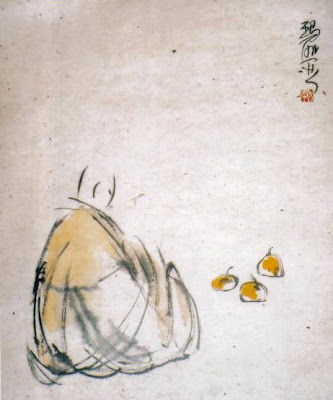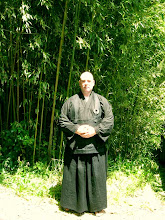
Dhyāna (from Sanskrit ध्यान dhyāna) or jhāna in Pāli refers to a stage of meditation, which is a subset of samādhi. It is a key concept in Hinduism, Buddhism, and Sikhism. Equivalent terms are "Chán" in modern Chinese, "Zen" in Japanese, "Seon" in Korean, "Thien" in Vietnamese, and "Samten" in Tibetan.

Dhyāna is very important in the Mahayana tradition. It is the fifth of six pāramitās (perfections). (Some traditions record ten rather than six paramitas)
It is usually translated as "concentration," “absorbtion,” “contemplation,” "meditation," or "meditative stability." In China, the word dhyāna was originally transliterated as chan-na (禅那; Mandarin: chánnà), and was later shortened to just chan (禅) in common usage.
Externally, Dhyana Paramita shows up as presence of mind or collectedness, meditation, contemplation. Internally, the practitioner strives to remain focused and centered and aware and see what is going on, rather than being heedless, mindless, absent-minded and distracted. This practice enables the practitioner to avoid becoming lost in fabrication, and to really see what is going on, right here and now, in the present moment. We can all do this, simply by applying a little attention and focus to the task of training the mind, body and spirit.
Innately, we are all totally absorbed. We are not capable of being anything but absorbed. We often may feel as though we are lost; that we are looking out through our eyes at the world, and at others in the world, but that we are somehow lost. But, this is not accurate. You are not lost at all! You are found! Innately, there is total presence, in practice, we often waste this presence; We miss the point entirely! We are side-tracked by issues that ultimately have no meaning in our lives, we overlook our mindful sense of presence, we detract from it with distorted views, notional thinking and preconceived opinions and idea, and therefore often miss the point entirely! It is as though we are looking at the world as though it were a reflection passed to us through many cracked mirrors - it is distorted and confusing. But, we have the ability to cease this useless sort of activity, to put an end to all of the distracted, pointless activities that we allow to take over our life and our world. When we allow these types of things to take center stage in our life, we end up feeling as though we are living our lives ‘part time’, or as though we are hearing or reading about our own lives, rather than living them, first hand. We feel like we are only operating on one or two cylinders. But we are just using the other cylinders to hold ourselves in. All the cylinders are going all the time. We ourselves are actually present at all times.. totally and continually. It is only through deluded thinking that we end up feeling otherwise. This is worth paying attention to, and taking the time to give some thought to, is it now? How can we not meditate on, contemplate upon, and reflect upon our lives?

It seems odd that sitting and doing what amounts to essentially nothing at all would have any relevance or value to our lives. But, it is often the ‘nothingness’ that makes a thing valuable - it is the nothingness in a hole, a door, a cup, and between the spokes of a wheel that lend value to those items. With us, it is the ability to re-connect with our silence, to dissolve our ego-selves to absolute zero, to find our center, and thus give ourselves a place from which we can more skillfully navigate the world that gives added value to our lives. When a glass is filled with muddy, silted, cloudy water, we cannot see anything clearly through it. However, if we simply leave it be.. and do not touch it or move it for some period of time, everything becomes clear.

Whether doing sitting meditation, walking meditation, chanting, visualization, yoga, martial arts, breathing exercises, prayers, or whatever, the joy of meditation rewards us deeply.

Dhyana, usually under the related term of samadhi, together with the second and sixth paramitas are also known as the three essential studies, or threefold training, of Buddhism: moral precepts (sila), meditation (dhyana or samadhi), and wisdom (prajna). In Mahayana Buddhism no one can be said to be accomplished in Buddhism who has not successfully trained in all three studies.

When Buddhism was brought to China, the Buddhist masters tended to become more focused or primarily adept in one of the three studies. Vinaya masters were those who specialized in the monastic rules of discipline and the moral precepts (sila). Dharma masters were those who specialized in the wisdom teachings of the Sutras and Buddhist treatises (shastras). Dhyana or Chan masters were those who specialized in meditation practice and states of samadhi. Monks would often begin their training under one kind of master, such as a Vinaya master, and then transfer to another master, such as a Dharma master or a Dhyana master, to further their training and studies. At that time there was no separate school known as Chan.

According to tradition, Bodhidharma brought his lineage school of a line of dhyāna masters from India to China. After a somewhat disappointing interview with an Emperor in the south of China, Bodhidharma went into the north and resided in relative obscurity at the Shaolin Temple until several disciples found him. As it became more and more independent, popular and politically influential, the lineage school that was attributed to Bodhidharma became known as the Chan school in China and was transplanted to Korea as Seon, to Japan as Zen, and to Vietnam as Thiền.
Arguably the most influential figure in Chinese Chan is Huineng who, beginning with Bodhidharma, is considered the sixth in line of the founders of the school of Chan Buddhism. Huineng is credited with firmly establishing Chan Buddhism as an independent Buddhist school in China. In the Platform Sutra Huineng says:

Learned Audience, what is sitting for meditation? In our School, to sit means to gain absolute freedom and to be mentally unperturbed in all outward circumstances, be they good or otherwise. To meditate means to realize inwardly the imperturbability of the Essence of Mind. Learned Audience, what are Dhyana and Samadhi? Dhyana means to be free from attachment to all outer objects, and Samadhi means to attain inner peace. If we are attached to outer objects, our inner mind will be perturbed. When we are free from attachment to all outer objects, the mind will be in peace. Our Essence of Mind is intrinsically pure, and the reason why we are perturbed is because we allow ourselves to be carried away by the circumstances we are in. He who is able to keep his mind unperturbed, irrespective of circumstances, has attained Samadhi. To be free from attachment to all outer objects is Dhyana, and to attain inner peace is Samadhi. When we are in a position to deal with Dhyana and to keep our inner mind in Samadhi, then we are said to have attained Dhyana and Samadhi. The Bodhisattva Sila Sutra says, "Our Essence of Mind is intrinsically pure." Learned Audience, let us realize this for ourselves at all times. Let us train ourselves, practice it by ourselves, and attain Buddhahood by our own effort.
In my own lineage, the Sixth Chinese Patriarch, Huineng, who is quoted above, is known as Eno Taikan. He is the 33rd Lineage holder in an unbroken line from the Historical Buddha, Siddhartha Gautama, (also known as Shakyamuni Buddha {The silent sage of the Shakya Clan} down to my Roshi, my teacher, and myself.

Rinzai Gigen, after whom my order is named is number 38, and my teacher is number 82. We liken the mind to mind transmission of this Dhyana or Zen as being similar to pouring water from one vessel to the next. The water takes the shape of the new bowl, cup, or jar.. but it remains essentially unchanged.

Dajian Huìnéng (慧能 or 惠能; Japanese: Daikan Enō; Korean: Hyeneung, 638–713) was a Chinese Chán monastic who is one of the most important figures in the entire tradition. Huineng is the Sixth and Last Patriarch of Chán Buddhism.
He is said to have advocated an immediate and direct approach to Buddhist practice and enlightenment, and in this regard, is considered the founder of the "Sudden Enlightenment" (頓教) Southern Chan school of Buddhism. His foremost students were Nanyue Huairang (or sometimes Huaijang -- in Japanese, he is known as Nangaku Ejo, and was the student that passed Master Huineng’s lineage down thru later students, and ultimately to me... and now to you!), Qingyuan Xingsi, Nanyang Huizhong, Yongia Xuanjue and Heze Shenhui.

So.. you can see how these Paramitas are passed, with great care and perhaps even greater love, from one hand to the next. It is a great gift that has been passed down, from master to disciple, generation to generation, over the years... coming, to my great joy, to me at long last.

Dhyana Paramita is, perhaps, the very essence of Zen practice, although this is not to say that the other five paramitas are not important; of course they are.. but, it is Dhyana from which Zen takes its very name! It is the central focus which affords us the ability to ultimately open our heart/mind to all of the others. There is wisdom in this, and wisdom is what I will be discussing with you next time, when the topic will be Prajna Paramita.
 Credit to Wikipedia for excerpts about various Zen Masters in this post
Credit to Wikipedia for excerpts about various Zen Masters in this post








































